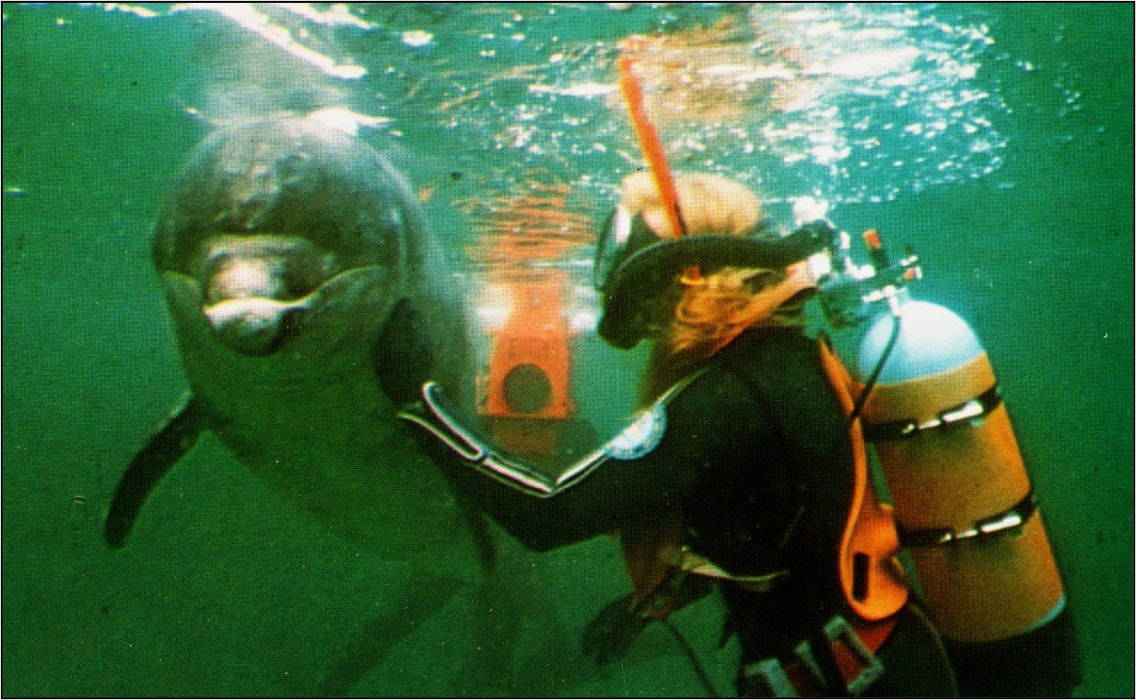Solitary dolphins
You may have heard of Donald the dolphin who was a popular Manx resident in the 1970s before he moved on to Wales and Cornwall (Lockyer 1978, download below). Donald was a solitary male bottlenose dolphin, a phenomenon which is not entirely uncommon around the world. A famous example is Fungie who was a resident in Dingle harbour since 1983 until his passing in October 2020.
Bottlenose dolphins are the most common dolphin species which exhibit solitary behaviour at times. It is thought that this happens because of the dolphins 'fission-fusion' society, in other words a very fluid and ever-changing social structure. Some years pods may not change at all, whilst other years it may reform completely due to bachelor males or mothers with juveniles moving around. Mother-calf pairs may move around as male bottlenose dolphins have been known to practice infanticide, that is killing the calf in order to free the female up again for mating. Solitary dolphins will not interact with other dolphins but may end up seeking out interaction with boats and humans, particularly around harbours and become a 'sociable, solitary dolphin'.
We now consider Moonlight and Starlight a 'solitary pair' as they have not been seen to interact with any other cetaceans since January 2020, and Starlight is showing some but not full similarity to sociable solitary dolphins. Since the beginning of their residence in Manx waters they have hunted very close to shore, in bays with human activity. Moonlight shows an expected level of confidence for a bottlenose dolphin with occasional bow riding and boat interaction. As Starlight has grown and is confident swimming more than a few body lengths from Moonlight she is showing increased interest around human activity. This includes bow riding boats and jet-skis, swimming around kayakers and paddle-boarders, and close approaches of swimmers or people wading the shallows. As yet interactions have only occurred with those already in the water, and no-one has yet entered the water to initiate an interaction or attempted to touch or swim with the dolphins, nor has Starlight approached close enough to initiate physical contact.
As Starlight has only ever known Manx waters, and for most of her life only interacted with her mother Moonlight, she may continue to display behaviour more similar to sociable, solitary dolphins than Moonlight who was a member of a large population prior to coming to the Isle of Man. In Lone Rangers, (Godwin and Dodds 2019, download below), their are six stages of habituation and the pair is displaying behaviour at stage 2, with elements of stage 4 as the pair is well-known to the Manx community.
To our knowledge there are no other documented cases of a solitary mother-calf pair of dolphins, but there have been many cases globally of solitary individuals. You can read about each one in the Lone Rangers document.
Bottlenose dolphins are the most common dolphin species which exhibit solitary behaviour at times. It is thought that this happens because of the dolphins 'fission-fusion' society, in other words a very fluid and ever-changing social structure. Some years pods may not change at all, whilst other years it may reform completely due to bachelor males or mothers with juveniles moving around. Mother-calf pairs may move around as male bottlenose dolphins have been known to practice infanticide, that is killing the calf in order to free the female up again for mating. Solitary dolphins will not interact with other dolphins but may end up seeking out interaction with boats and humans, particularly around harbours and become a 'sociable, solitary dolphin'.
We now consider Moonlight and Starlight a 'solitary pair' as they have not been seen to interact with any other cetaceans since January 2020, and Starlight is showing some but not full similarity to sociable solitary dolphins. Since the beginning of their residence in Manx waters they have hunted very close to shore, in bays with human activity. Moonlight shows an expected level of confidence for a bottlenose dolphin with occasional bow riding and boat interaction. As Starlight has grown and is confident swimming more than a few body lengths from Moonlight she is showing increased interest around human activity. This includes bow riding boats and jet-skis, swimming around kayakers and paddle-boarders, and close approaches of swimmers or people wading the shallows. As yet interactions have only occurred with those already in the water, and no-one has yet entered the water to initiate an interaction or attempted to touch or swim with the dolphins, nor has Starlight approached close enough to initiate physical contact.
As Starlight has only ever known Manx waters, and for most of her life only interacted with her mother Moonlight, she may continue to display behaviour more similar to sociable, solitary dolphins than Moonlight who was a member of a large population prior to coming to the Isle of Man. In Lone Rangers, (Godwin and Dodds 2019, download below), their are six stages of habituation and the pair is displaying behaviour at stage 2, with elements of stage 4 as the pair is well-known to the Manx community.
To our knowledge there are no other documented cases of a solitary mother-calf pair of dolphins, but there have been many cases globally of solitary individuals. You can read about each one in the Lone Rangers document.
| Goodwin and Dodds 2019 - Lone rangers: a report on solitary dolphins | |
| File Size: | 2835 kb |
| File Type: | |
| Lockyer 1978 - History and behaviour of a solitary wild but sociable bottlenose dolphin | |
| File Size: | 6745 kb |
| File Type: | |
donald the dolphin in the 1970's with maura mitchell. Image copyright D. aspinall


